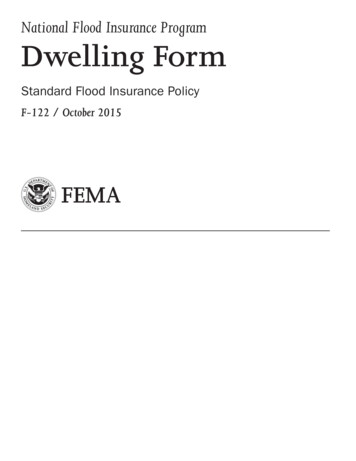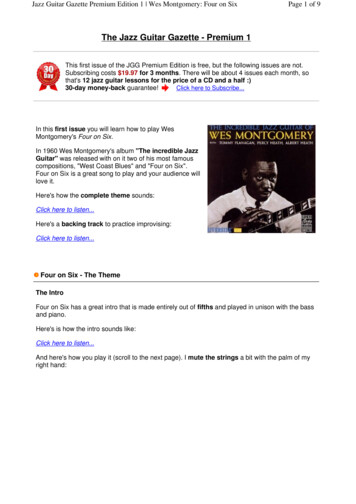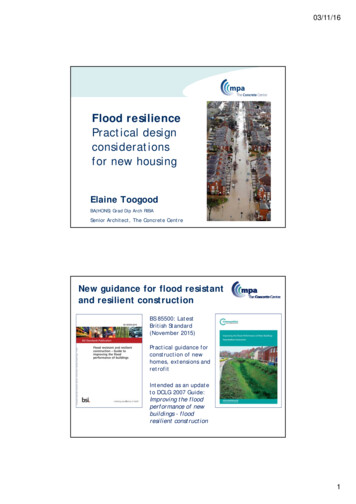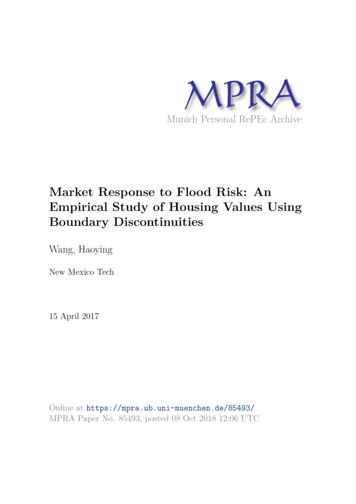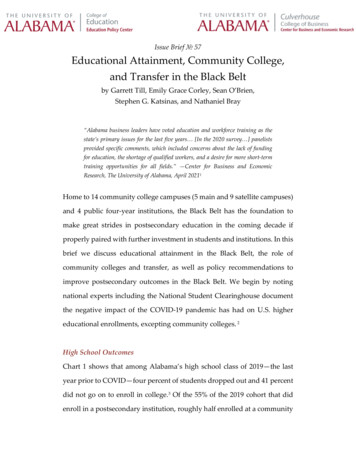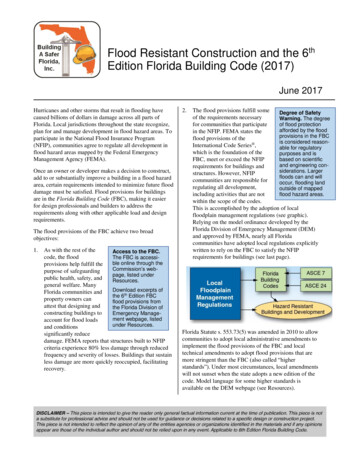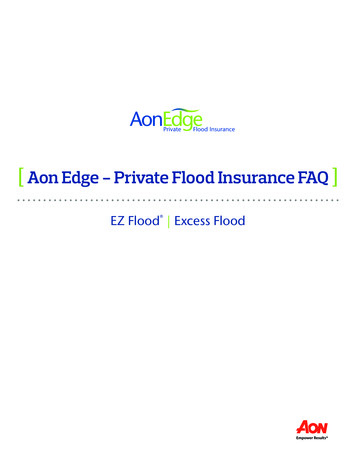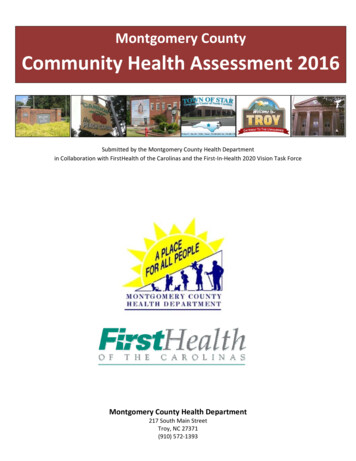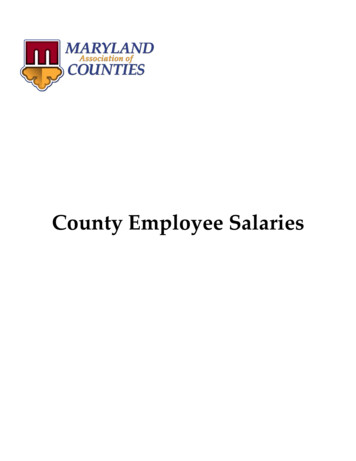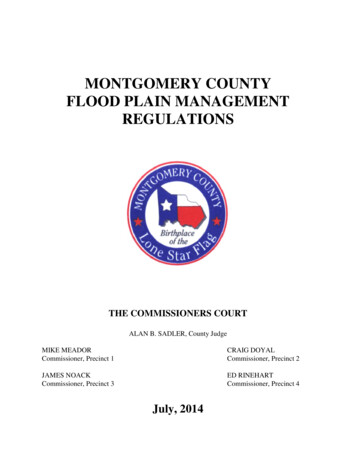
Transcription
MONTGOMERY COUNTYFLOOD PLAIN MANAGEMENTREGULATIONSTHE COMMISSIONERS COURTALAN B. SADLER, County JudgeMIKE MEADORCommissioner, Precinct 1CRAIG DOYALCommissioner, Precinct 2JAMES NOACKCommissioner, Precinct 3ED RINEHARTCommissioner, Precinct 4July, 2014
Montgomery CountyFlood Plain Management RegulationsPage 2TABLE OF CONTENTSARTICLE I - STATUTORY AUTHORIZATION, FINDINGS OF FACT, PURPOSEAND METHODS.4SECTION A. STATUTORY AUTHORIZATION .4SECTION B. FINDINGS OF FACT .4SECTION C. STATEMENT OF PURPOSE.4SECTION D. METHODS OF REDUCING FLOOD LOSSES .5SECTION E. SEVERABILITY .5ARTICLE II - DEFINITIONS .6ARTICLE III – GENERAL PROVISIONS .13SECTION A. LANDS TO WHICH THESE REGULATIONS APPLY .13SECTION B. BASIS FOR ESTABLISHING SPECIAL FLOOD HAZARDAREAS .13SECTION C. ESTABLISHMENT OF DEVELOPMENT PERMITS .13SECTION D. COMPLIANCE .13SECTION E. ABROGATION AND GREATER RESTRICTIONS .13SECTION F. INTERPRETATION .13SECTION G. WARNING AND DISCLAIMER OF LIABILITY .13ARTICLE IV - ADMINISTRATION .15SECTION A. DESIGNATION OF THE FLOOD PLAIN ADMINISTRATOR .15SECTION B. DUTIES & RESPONSIBILITIES OF THE FLOOD PLAINADMINISTRATOR.15SECTION C. PERMIT PROCEDURES .16SECTION D. VARIANCES AND APPEALS .18SECTION E. FEES .20SECTION F. RESPONSIBILITY OF OTHER OFFICIALS.20ARTICLE V - PROVISIONS FOR FLOOD HAZARD REDUCTION .21SECTION A. GENERAL STANDARDS .21SECTION B. SPECIFIC STANDARDS .21SECTION C. STANDARDS FOR SUBDIVISION PROPOSALS .23SECTION D. STANDARDS FOR AREAS OF SHALLOW FLOODING(AO/AH ZONES) .24SECTION E. FLOODWAYS .25
Montgomery CountyFlood Plain Management RegulationsPage 3SECTION F. EXEMPTIONS .26SECTION G. STANDARDS FOR COMMERCIAL DEVELOPMENTS .26ARTICLE VI - PROCEDURES .27SECTION A. INSPECTIONS .27SECTION B. NON-COMPLIANT WORK .27SECTION C. PERMIT TERM .27SECTION D. VIOLATION NOTICE.27SECTION E. ENFORCEMENT, VIOLATION AND PENALTIES .27
Montgomery CountyFlood Plain Management RegulationsPage 4ARTICLE I - STATUTORY AUTHORIZATION, FINDINGS OF FACT, PURPOSE ANDMETHODSSECTION A. STATUTORY AUTHORIZATIONThe Legislature of the State of Texas has in the Flood Control Insurance Act, Texas Water Code,Section 16.315 delegated the responsibility of local governmental units to adopt regulationsdesigned to minimize flood losses. Therefore, the Commissioners Court of Montgomery County,Texas establishes the following regulations.SECTION B. FINDINGS OF FACT(1) The flood hazard areas of Montgomery County are subject to periodic inundation,which results in loss of life and property, health and safety hazards, disruption of commerce andgovernmental services, and extraordinary public expenditures for flood protection and relief, allof which adversely affect the public health, safety and general welfare.(2) These flood losses are created by the cumulative effect of obstructions in flood plainswhich cause an increase in flood heights and velocities, and by the occupancy of flood hazardareas by uses vulnerable to floods and hazardous to other lands because they are inadequatelyelevated, flood-proofed or otherwise protected from flood damage.SECTION C. STATEMENT OF PURPOSEIt is the purpose of these regulations to promote the public health, safety and general welfare andto minimize public and private losses due to flood conditions in specific areas by provisionsdesigned to:(1)protect human life and health;(2)minimize expenditure of public money for costly flood control projects;(3) minimize the need for rescue and relief efforts associated with flooding and generallyundertaken at the expense of the general public;(4)minimize prolonged business interruptions;(5) minimize damage to public facilities and utilities such as water and gas mains,electric, telephone and sewer lines, streets and bridges located in flood plains;
Montgomery CountyFlood Plain Management RegulationsPage 5(6) help maintain a stable tax base by providing for the sound use and development offlood-prone areas in such a manner as to minimize future flood blight areas; and(7)ensure that potential buyers are notified that property is in a flood area.SECTION D. METHODS OF REDUCING FLOOD LOSSESIn order to accomplish its purposes, these regulations use the following methods:(1) restrict or prohibit uses that are dangerous to health, safety or property in times offlood, or cause excessive increases in flood heights or velocities;(2) require that uses vulnerable to floods, including facilities which serve such uses, beprotected against flood damage at the time of initial construction;(3) control the alteration of natural flood plains, stream channels, and natural protectivebarriers, which are involved in the accommodation of flood waters;(4)damage;control filling, grading, dredging and other development which may increase flood(5) prevent or regulate the construction of flood barriers which will unnaturally divertflood waters or which may increase flood hazards to other lands.SECTION E. SEVERABILITYThe provisions of these regulations are severable. If any word, phrase, clause, sentence, section,provision, or part of these regulations is held to be invalid or unconstitutional by any court ofcompetent jurisdiction, then said holding shall in no way affect the validity of the remainingportions of these regulations.
Montgomery CountyFlood Plain Management RegulationsPage 6ARTICLE II - DEFINITIONSUnless specifically defined below, words or phrases used in these regulations shall be interpretedto give them the meaning they have in common usage and to give these regulations the mostreasonable application.ALLUVIAL FAN FLOODING – means flooding occurring on the surface of an alluvial fan orsimilar landform which originates at the apex and is characterized by high velocity flows, activeprocesses of erosion, sediment transport and deposition, and unpredictable flow paths.APEX – means a point on an alluvial fan or similar landform below which the flow path of themajor stream that formed the fan becomes unpredictable and alluvial fan flooding can occur.APPURTENANT STRUCTURE – means a structure which is on the same parcel of property asthe principal structure and the use of which is incidental to the use of the principal structure.AREA OF FUTURE CONDITIONS FLOOD HAZARD – means the land area that would beinundated by the one percent annual chance (100-year) flood based on future conditionshydrology.AREA OF SHALLOW FLOODING - means a designated AO, AH, AR/AO, AR/AH, or VOzone on a community's Flood Insurance Rate Map (FIRM) with a one percent or greater annualchance of flooding to an average depth of one to three feet where a clearly defined channel doesnot exist, where the path of flooding is unpredictable and where velocity flow may be evident.Such flooding is characterized by ponding or sheet flow.BASE FLOOD - means the flood having a one percent chance of being equaled or exceeded inany given year.BASE FLOOD ELEVATION (BFE) – The elevation shown on the Flood Insurance Rate Map(FIRM) and found in the accompanying Flood Insurance Study (FIS) for Zones A, AE, AH, A1A30, AR, V1-V30, or VE that indicates the water surface elevation resulting from the flood thathas a one percent chance of equaling or exceeding that level in any given year, also called theBase Flood.BASEMENT - means any area of the building having its floor subgrade (below ground level) onall sides.BREAKAWAY WALL – means a wall that is not part of the structural support of the buildingand is intended through its design and construction to collapse under specific lateral loading
Montgomery CountyFlood Plain Management RegulationsPage 7forces, without causing damage to the elevated portion of the building or supporting foundationsystem.CRITICAL FEATURE - means an integral and readily identifiable part of a flood protectionsystem, without which the flood protection provided by the entire system would becompromised.DEVELOPMENT - means any man-made change to improved and unimproved real estate,including but not limited to buildings or other structures, mining, dredging, filling, grading,paving, excavation or drilling operations or storage of equipment or materials.ELEVATED BUILDING – means, for insurance purposes, a non-basement building, which hasits lowest elevated floor, raised above ground level by foundation walls, shear walls, posts, piers,pilings, or columns.EXISTING CONSTRUCTION - means for the purposes of determining rates, structures forwhich the "start of construction" commenced before the effective date of the FIRM or beforeJanuary 1, 1975, for FIRMs effective before that date. "Existing Construction" may also bereferred to as "Existing Structures."EXISTING MANUFACTURED HOME PARK OR SUBDIVISION - means a manufacturedhome park or subdivision for which the construction of facilities for servicing the lots on whichthe manufactured homes are to be affixed (including, at a minimum, the installation of utilities,the construction of streets, and either final site grading or the pouring of concrete pads) iscompleted before the effective date of the flood plain management regulations adopted by acommunity.EXISTING STRUCTURE – See Existing Construction.EXPANSION TO AN EXISTING MANUFACTURED HOME PARK OR SUBDIVISION means the preparation of additional sites by the construction of facilities for servicing the lots onwhich the manufactured homes are to be affixed (including the installation of utilities, theconstruction of streets, and either final site grading or the pouring of concrete pads).FLOOD OR FLOODING - means a general and temporary condition of partial or completeinundation of normally dry land areas from:(1) the overflow of inland or tidal waters.(2) the unusual and rapid accumulation or runoff of surface waters from any source.FLOOD ELEVATION DETERMINATION – means a determination by the flood plainadministrator of the water surface elevations of the base flood.
Montgomery CountyFlood Plain Management RegulationsPage 8FLOOD ELEVATION STUDY – means an examination, evaluation, and determination offlood hazards and, if applicable, corresponding water surface elevations, or an examination,evaluation and determination of mudslide (i.e., mudflow) and/or flood-related erosion hazards.FLOOD INSURANCE RATE MAP (FIRM) - means an official map of a community, onwhich the Federal Emergency Management Agency has delineated both the special flood hazardareas and the risk premium zones applicable to the community.FLOOD INSURANCE STUDY (FIS) – means the official report provided by the FederalEmergency Management Agency. The report contains flood profiles, water surface elevation ofthe base flood, as well as the Flood Boundary-Floodway map.FLOOD PLAIN – means the land area susceptible to being inundated by water during the baseflood and indicated on the flood insurance rate map as Zones A, AO, AH, A1-30, AE, A99, AR,AR/A1-30, AR/AE, AR/AO, AR/AH, AR/A, VO, V1-30, VE or V.FLOOD-PRONE AREA - means any land area susceptible to being inundated by water fromany source (see definition of flooding).FLOOD PLAIN ADMINISTRATOR – The person appointed by Commissioners Court ashaving the responsibility to implement these regulations.FLOOD PLAIN MANAGEMENT - means the operation of an overall program of correctiveand preventive measures for reducing flood damage, including but not limited to emergencypreparedness plans, flood control works and flood plain management regulations.FLOOD PLAIN MANAGEMENT REGULATIONS – means these regulations, court orders,subdivision regulations, building codes, health regulations, special purpose orders (such as aflood plain orders, grading orders and erosion control orders) and other applications of policepower. The term describes such state or local regulations, in any combination thereof, whichprovide standards for the purpose of flood damage prevention and reduction.FLOOD PROTECTION SYSTEM - means those physical structural works for which fundshave been authorized, appropriated, and expended and which have been constructed specificallyto modify flooding in order to reduce the extent of the area within a community subject to a"special flood hazard" and the extent of the depths of associated flooding. Such a systemtypically includes hurricane tidal barriers, dams, reservoirs, levees or dikes. These specializedflood modifying works are those constructed in conformance with sound engineering standards.FLOOD PROOFING - means any combination of structural and non-structural additions,changes, or adjustments to structures which reduce or eliminate flood damage to real estate orimproved real property, water and sanitary facilities, structures and their contents.
Montgomery CountyFlood Plain Management RegulationsPage 9FLOODWAY (REGULATORY FLOODWAY) - means the channel of a river or otherwatercourse and the adjacent land areas that must be reserved in order to discharge the base floodwithout cumulatively increasing the water surface elevation more than a designated height.FUNCTIONALLY DEPENDENT USE - means a use, which cannot perform its intendedpurpose unless it is located or carried out in close proximity to water. The term includes onlydocking facilities, port facilities that are necessary for the loading and unloading of cargo orpassengers, and ship building and ship repair facilities, but does not include long-term storage orrelated manufacturing facilities.HIGHEST ADJACENT GRADE - means the highest natural elevation of the ground surfaceprior to construction next to the proposed walls of a structure.HISTORIC STRUCTURE - means any structure that is:(1) listed individually in the National Register of Historic Places (a listing maintained bythe Department of Interior) or preliminarily determined by the Secretary of the Interior asmeeting the requirements for individual listing on the National Register;(2) certified or preliminarily determined by the Secretary of the Interior as contributing tothe historical significance of a registered historic district or a district preliminarily determined bythe Secretary to qualify as a registered historic district;(3) individually listed on a state inventory of historic places in states with historicpreservation programs which have been approved by the Secretary of the Interior; or(4) individually listed on a local inventory or historic places in communities with historicpreservation programs that have been certified either:(a) by an approved state program as determined by the Secretary of the Interior or;(b) directly by the Secretary of the Interior in states without approved programs.LEVEE - means a man-made structure, usually an earthen embankment, designed andconstructed in accordance with sound engineering practices to contain, control, or divert the flowof water so as to provide protection from temporary flooding.LEVEE SYSTEM - means a flood protection system which consists of a levee, or levees, andassociated structures, such as closure and drainage devices, which are constructed and operatedin accordance with sound engineering practices.
Montgomery CountyFlood Plain Management RegulationsPage 10LOWEST FLOOR - means the lowest floor of the lowest enclosed area (including basement).An unfinished or flood resistant enclosure, usable solely for parking or vehicles, building accessor storage in an area other than a basement area is not considered a building's lowest floor;provided that such enclosure is not built so as to render the structure in violation of the applicablenon-elevation design requirement of Section 60.3 of the National Flood Insurance Programregulations.MANUFACTURED HOME - means a structure transportable in one or more sections, which isbuilt on a permanent chassis and is designed for use with or without a permanent foundationwhen connected to the required utilities. The term "manufactured home" does not include a"recreational vehicle".MANUFACTURED HOME PARK OR SUBDIVISION - means a parcel (or contiguousparcels) of land divided into two or more manufactured home lots for rent or sale.MEAN SEA LEVEL - means, for purposes of the National Flood Insurance Program, the NorthAmerican Vertical Datum (NAVD) of 1988 or other datum, to which base flood elevationsshown on a community's Flood Insurance Rate Map are referenced.NEW CONSTRUCTION - means, for the purpose of determining insurance rates, structures forwhich the "start of construction" commenced on or after the effective date of an initial FIRM orafter December 31, 1974, whichever is later, and includes any subsequent improvements to suchstructures. For flood plain management purposes, "new construction" means structures for whichthe "start of construction" commenced on or after the effective date of a flood plain managementregulation adopted by a community and includes any subsequent improvements to suchstructures.NEW MANUFACTURED HOME PARK OR SUBDIVISION - means a manufactured homepark or subdivision for which the construction of facilities for servicing the lots on which themanufactured homes are to be affixed (including at a minimum, the installation of utilities, theconstruction of streets, and either final site grading or the pouring of concrete pads) is completedon or after the effective date of flood plain management regulations adopted by a community.RECREATIONAL VEHICLE - means a vehicle which is (1) built on a single chassis; (2) 400square feet or less when measured at the largest horizontal projections; (3) designed to be selfpropelled or permanently towable by a light duty truck; and (4) designed primarily not for use asa permanent dwelling but as temporary living quarters for recreational, camping, travel, orseasonal use.REGULATORY FLOODWAY – See Floodway.
Montgomery CountyFlood Plain Management RegulationsPage 11RIVERINE – means relating to, formed by, or resembling a river (including tributaries), stream,brook, etc.SPECIAL FLOOD HAZARD AREA – is the land in the flood plain within a communitysubject to a 1 percent or greater chance of flooding in any given year. This area is typicallyreferred to as Zones A, AO, AH, A1-30, AE, A99, AR, AR/A1-30, AR/AE, AR/AO, AR/AH,AR/A, VO, V1-30, VE or V on the Flood Insurance Rate Map.START OF CONSTRUCTION - (for other than new construction or substantial improvementsunder the Coastal Barrier Resources Act (Pub. L. 97-348)), includes substantial improvement andmeans the date the development permit was issued, provided the actual start of construction,repair, reconstruction, rehabilitation, addition placement, or other improvement was within 180days of the permit date. The actual start means either the first placement of permanentconstruction of a structure on a site, such as the pouring of slab or footings, the installation ofpiles, the construction of columns, or any work beyond the stage of excavation; or the placementof a manufactured home on a foundation. Permanent construction does not include landpreparation, such as clearing, grading and filling; nor does it include the installation of streetsand/or walkways; nor does it include excavation for basement, footings, piers or foundations orthe erection of temporary forms; nor does it include the installation on the property of accessorybuildings, such as garages or sheds not occupied as dwelling units or not part of the mainstructure. For a substantial improvement, the actual start of construction means the firstalteration of any wall, ceiling, floor, or other structural part of a building, whether or not thatalteration affects the external dimensions of the building.STRUCTURE – means, for flood plain management purposes, a walled and roofed building,including a gas or liquid storage tank, that is principally above ground, as well as a manufacturedhome.SUBSTANTIAL DAMAGE - means damage of any origin sustained by a structure whereby thecost of restoring the structure to its before damaged condition would equal or exceed fifty percentof the market value of the structure before the damage occurred.SUBSTANTIAL IMPROVEMENT - means any reconstruction, rehabilitation, addition, orother improvement of a structure, the cost of which equals or exceeds fifty percent of the marketvalue of the structure before "start of construction" of the improvement. This term includesstructures which have incurred "substantial damage", regardless of the actual repair workperformed. The term does not, however, include either: (1) any project for improvement of astructure to correct existing violations of state or local health, sanitary, or safety codespecifications which have been identified by the local code enforcement official and which arethe minimum necessary to assure safe living conditions or (2) any alteration of a "historicstructure", provided that the alteration will not preclude the structure's continued designation as a"historic structure."
Montgomery CountyFlood Plain Management RegulationsPage 12UNINCORPORATED AREA – means land area within Montgomery County, Texas outsidethe incorporated areas of cities, towns, and villages.VARIANCE – means a grant of relief by a community from the terms of a flood plainmanagement regulation. For full requirements see Section 60.6 of the National Flood InsuranceProgram regulations.VIOLATION - means the failure of a structure or other development to be fully compliant withthe community's flood plain management regulations. A structure or other development withoutthe elevation certificate, other certifications, or other evidence of compliance required in Section60.3(b)(5), (c)(4), (c)(10), (d)(3), (e)(2), (e)(4), or (e)(5) is presumed to be in violation until suchtime as that documentation is provided.WATER SURFACE ELEVATION - means the height, in relation to the North AmericanVertical Datum (NAVD) of 1988 or other datum, where specified, of floods of variousmagnitudes and frequencies in the flood plains of coastal or riverine areas.
Montgomery CountyFlood Plain Management RegulationsPage 13ARTICLE III – GENERAL PROVISIONSSECTION A. LANDS TO WHICH THESE REGULATIONS APPLYThese regulations shall apply to all unincorporated areas within the jurisdiction of MontgomeryCounty, Texas.SECTION B. BASIS FOR ESTABLISHING SPECIAL FLOOD HAZARD AREASThe special flood hazard areas identified by the Federal Emergency Management Agency in thecurrent scientific and engineering report entitled, “The Flood Insurance Study for MontgomeryCounty" (FIS) dated August 18, 2014, with accompanying Flood Insurance Rate Maps (FIRM)and any revisions thereto are hereby adopted by reference and declared to be a part of theseregulations.SECTION C. ESTABLISHMENT OF DEVELOPMENT PERMITSA development permit shall be required to ensure conformance with the provisions of theseregulations.SECTION D. COMPLIANCENo structure or land shall hereafter be located, altered, or have its use changed without fullcompliance with the terms of these regulations and other applicable regulations.SECTION E. ABROGATION AND GREATER RESTRICTIONSThese regulations are not intended to repeal, abrogate, or impair any existing easements,covenants, or deed restrictions. However, where these regulations and another ordinance,easement, covenant, or deed restriction conflict or overlap, whichever imposes the more stringentrestrictions shall prevail.SECTION F. INTERPRETATIONIn the interpretation and application of these regulations, all provisions shall be: (1) considered asminimum requirements; (2) liberally construed in favor of the governing body; and (3) deemedneither to limit nor repeal any other powers granted under State statutes.SECTION G. WARNING AND DISCLAIMER OF LIABILITYThe degree of flood protection required by these regulations is considered reasonable forregulatory purposes and is based on scientific and engineering considerations. On rare occasions
Montgomery CountyFlood Plain Management RegulationsPage 14greater floods can and will occur and flood heights may be increased by man-made or naturalcauses. These regulations do not imply that land outside the special flood hazard areas or usespermitted within such areas will be free from flooding or flood damages. These regulations shallnot create liability on the part of the community or any official or employee thereof for any flooddamages that result from reliance on these regulations or any administrative decision lawfullymade hereunder.
Montgomery CountyFlood Plain Management RegulationsPage 15ARTICLE IV - ADMINISTRATIONSECTION A. DESIGNATION OF THE FLOOD PLAIN ADMINISTRATORThe Commissioners Court shall appoint the Flood Plain Administrator to administer andimplement the provisions of these regulations and other appropriate sections of 44 CFR,Emergency Management and Assistance - National Flood Insurance Program Regulations,pertaining to flood plain management.SECTION B. DUTIES & RESPONSIBILITIES OF THE FLOOD PLAINADMINISTRATORDuties and responsibilities of the Flood Plain Administrator shall include, but not be limited to,the following:(1) Maintain and hold open for public inspection all records pertaining to the provisionsof these regulations.(2) Review development permit applications to ensure that the proposed building siteproject, including the placement of manufactured homes, will be reasonably safe from flooding.(3) Review, approve or deny all applications for development permits required byadoption of these regulations.(4) Review permits for proposed development to assure that all necessary permits havebeen obtained from those federal, state, or local governmental agencies (including Section 404 ofthe Federal Water Pollution Control Act Amendments of 1972, 33 U.S.C. 1334) from whichprior approval is required.(5) Where interpretation is needed as to the exact location of the boundaries of the specialflood hazard areas, for example, where there appears to be a conflict between a mapped boundaryand actual field conditions, the Flood Plain Administrator shall make the necessaryinterpretation.(6) Notify, in riverine situations, adjacent communities and the State CoordinatingAgency which is the Texas Water Development Board (TWDB) and also the Texas Commissionon Environmental Quality (TCEQ), prior to any alteration or relocation of a watercourse, andsubmit evidence of such notification to the Federal Emergency Management Agency.
Montgomery CountyFlood Plain Management RegulationsPage 16(7) Assure that the flood carrying capacity within the altered or relocated portion of anywatercourse is maintained.(8) When base flood elevation data has not been provided in accordance with Article III,Section B, the Flood Plain Administrator shall obtain, review and reasonably utilize any baseflood elevation data and floodway data available from a federal, state or other source, in order toadminister the provisions of Article V.(9) When a regulatory floodway has not been designated, the Flood Plain Administratormust require that no new construction, substantial improvements, or other development(including fill) shall be permitted within Zones A1-30 and AE on the community's FIRM, unlessit is demonstrated that the cumulative effect of the proposed development, when combined withall other existing and anticipated development, will not increase the water surface elevation ofthe base flood at any point within the community.(10) Under the provisions of 44 CFR Chapter 1, Section 65.12, of the National FloodInsurance Program regulations, a community may approve certain development in Zones A1-30,AE, and AH, on the community's FIRM which increases the water surface elevation of the baseflood provided that the community first completes all of the prov
FLOOD INSURANCE RATE MAP (FIRM) - means an official map of a community, on which the Federal Emergency Management Agency has delineated both the special flood hazard areas and the risk premium zones applicable to the community. FLOOD INSURANCE STUDY (FIS) - means the official report provided by the Federal
